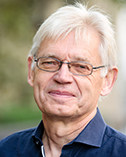
Peter Hegemann
Humboldt University Berlin
|
Primary Section: 23, Physiology and Pharmacology Secondary Section: 24, Cellular and Molecular Neuroscience Membership Type:
International Member
(elected 2022)
|
Biosketch
Peter Hegemann is a biochemist and biophysicist recognized for his work on the photophysiology of green alga Chlamydomonas where he discovered the channelrhodopsins as functional photoreceptors for phototaxis. Channelrhodopsins became famous for their optogenetic application in the neurosciences to regulate cellular activity with light. Hegemann was born in Muenster and grew up in Aachen, Germany. He graduated in Chemistry and got his doctoral degree in Biochemistry at the Ludwig Maximilian University (LMU) Muenchen in 1994 followed by a short PostDoc at the physics Department of Syracuse University. He got an independent research group at the Max-Institute of Biochemistry in Martinsried, he became Professor for Biochemistry in Regensburg in 1993, Professor for Biophysics at the Humboldt-Universität zu Berlin in 2005, and Hertie Professorship for Neurosciences in 2016. He is a member of the German National Academy Leopoldina, the European Molecular Biology Organisation (EMBO), and the Berlin Brandenburg Academy of Science.
Research Interests
Hegemann's research focused almost entirely on the characterization of natural sensory photoreceptors, mainly from microalgae. Hegemann has characterized behavioral and photoelectric responses of the unicellular alga Chlamydomonas, a work that cumulated in the claim that the photoreceptors for these responses was a rhodopsin that unified the sensor and ion channel in one protein. He finally proved this hypothesis by identifying the light-gated channel channelrhodopsin, and by demonstrating its functionality in animal cells. Of equal importance, his group discovered the fundamental principles of the unique channelrhodopsin proteins in molecular detail by a wide range of genomic, biophysical, electrophysiological, and structural techniques with many mutants which led to the deciphering of the unprecedented light-gated ion channel mechanism, including its pore gating by photons and its ion selectivity. This basic work also fundamentally enabled optogenetics, the technology wherein light-activated proteins- first and foremost channelrhodopsin- allow control of selected cells within systems as complex as the mammalian brain, with unprecedented precision in space and time, by delivery of light.

